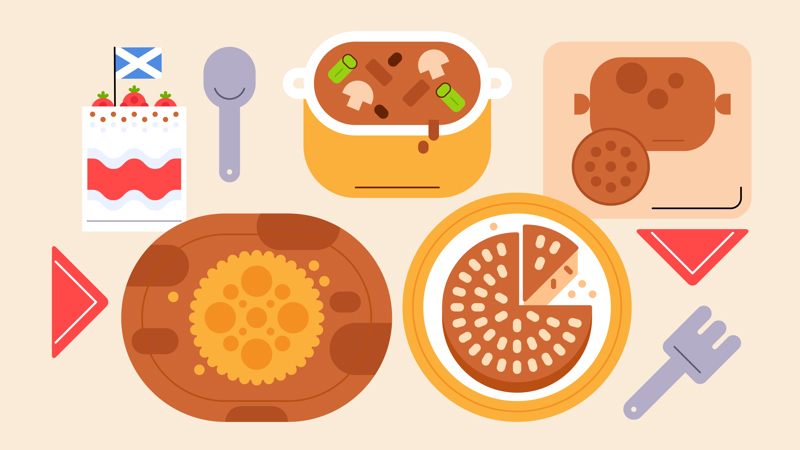
Crowdie or cranachan?
You’ll need
- Pens or pencils
- A4 paper
- Tables
- Chairs
- Blindfolds
- Kitchenware
- A basin of warm water
- Tea towels
- A selection of traditional Scottish dishes (e.g. bannock, Dundee cake, clootie dumpling, cranachan, haggis, rumbledethumps, crowdie, cock-a-leekie soup, Abernethy biscuits)
Before you begin
- Use the safety checklist to help you plan and risk assess your activity. Additional help to carry out your risk assessment, including examples can be found here. Don’t forget to make sure all young people and adults involved in the activity know how to take part safely.
- Make sure you’ll have enough adult helpers. You may need some parents and carers to help if you’re short on helpers.
- Check for any allergies or dietary requirements and adjust the tasting options accordingly.
Preparing for tasting
- Make sure that they have at least five different dishes for the group to try.
- Make sure that the dishes are safe to be eaten by the members of your group and can be served from your meeting place.
- Print copies of the ‘Score sheet’ so that everyone in the group will have one.
Test your taste buds
- Place each of the Scottish foods in dishes on the table. Label each dish with its name. Place the copies of the ‘Score sheet’ and the pens or pencils at one end of the table, and a basin of water and tea towels at the other.
Make sure that each dish has the right cutlery, so that it’s easy to taste. It may be that you’ll need to assist with foods that need cutting before eating.
- Everyone should gather around the table and have a look at the food. See if anyone recognises any of the items. The group may smell or look closely at each dish, but they may not taste them just yet.
- Everyone should split into pairs. The person leading the activity should set up a row of five chairs opposite each dish. They should explain to the group that they’ll be tasting the dishes blindfolded. One from each pair will wear a blindfold and taste, while the other feeds them and keeps score on a ‘Score sheet.’
- Choose a pair to go first. The blindfolded person should sit in the first chair. The person keeping score should write their taster’s and their own name on a ‘Score sheet.’ Then, they should take a small amount of food from one of the dishes and feed it to their partner.
- If the partner correctly guesses what it is, they get ‘1’ point on the ‘Score sheet.’ If they guess incorrectly, they get ‘0’ points on the ‘Score sheet.’
- Next to each score, the person scoring should write the name of the dish that was just tried and what the taster thought it was, in the right column.
- After each dish is tried, the person keeping score should wash the spoon in the warm water, before repeating the process.
- Continue until the blindfolded person has tried all five dishes and completed their ‘Score sheet.’ At this point, the person keeping score should give the ‘Score sheet’ to the person leading the activity.
- Once all the pairs have completed the challenge, the person leading the activity can announce the winner.
- All the ‘Score sheets’ can be returned to the tasters, so that they can see which foods they got and which they didn’t. The group is now free to discuss which foods they liked and disliked.
Reflection
The group have tried some Scottish foods. It is likely that many of the group will be trying some of the dishes for the very first time. What did they taste like? Was it uncomfortable or exciting to try new foods with a blindfold on? How similar were the dishes to food that you often eat at home?
Trying the food while not being able to see would have made it more difficult to identify the dish that you were trying. Tasters, did your scorer mix up the order of the dishes to make it difficult? How did you decide what to choose when you weren’t sure, did you rely purely on what ingredients you could taste? Scorers, in what order did you feed the tasters, and were you looking to make it easy or tough for them to guess?
Safety
All activities must be safely managed. You must complete a thorough risk assessment and take appropriate steps to reduce risk. Use the safety checklist to help you plan and risk assess your activity. Always get approval for the activity, and have suitable supervision and an InTouch process.
- Food
Remember to check for allergies, eating problems, fasting or dietary requirements and adjust the recipe as needed. Make sure you’ve suitable areas for storing and preparing food and avoid cross contamination of different foods. Take a look at our guidance on food safety and hygiene.
- Water games and activities
Be careful when doing activities with, in, or near water. Check surfaces and reduce the risk of slipping where possible. Make sure you have appropriate supervision for this activity.
Some members of the group may wish to taste all of the food before they take part in the blind tasting. Other dishes could be introduced to make the activity more difficult – you could even introduce something that wasn’t there at the start while the taster is blindfolded, if they have turbo taste buds.
● Anyone uncomfortable wearing a blindfold should close their eyes and be guided instead.
● Anyone uncomfortable tasting the food blind could hear a description of how the food tastes instead, and try to guess from that.
All Scout activities should be inclusive and accessible.
The group should test their taste buds by trying to identify the ingredients that they think are included in the Scottish dishes. Allow them to try the food again and use their other senses – smell, touch and sight – to pick up on aromas, textures and colours. This could help the group create a recipe book with Scottish dishes and dishes from other parts of the world that they have tried.
If anyone wants to take this activity further by bringing in food from other cultures, this should be allowed so that everyone can share in the experience. Care should be taken to accommodate for allergies and food intolerances.


